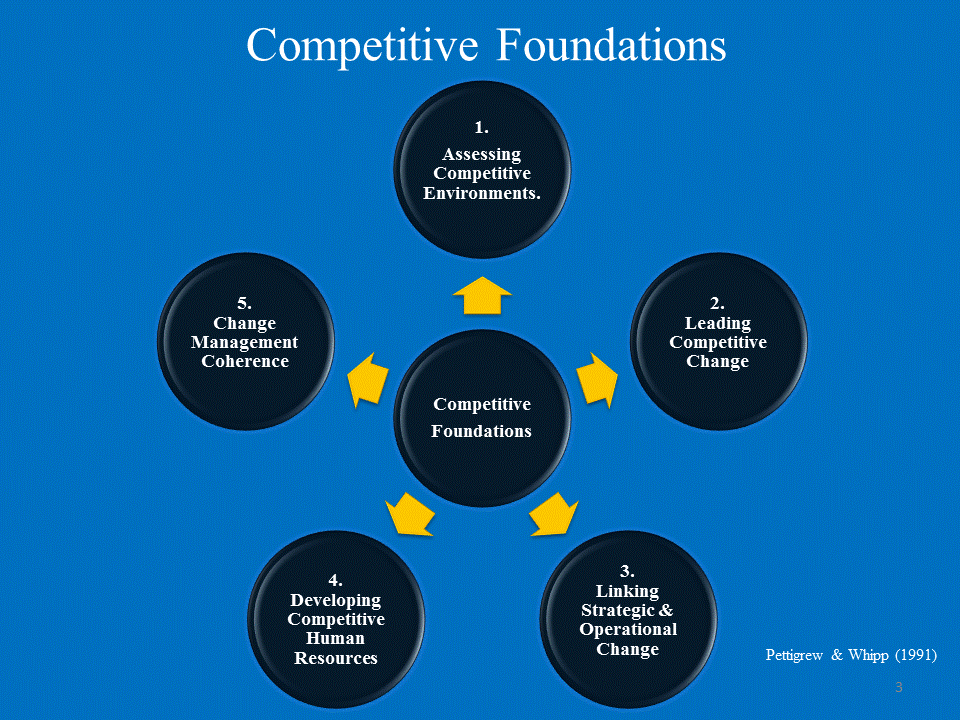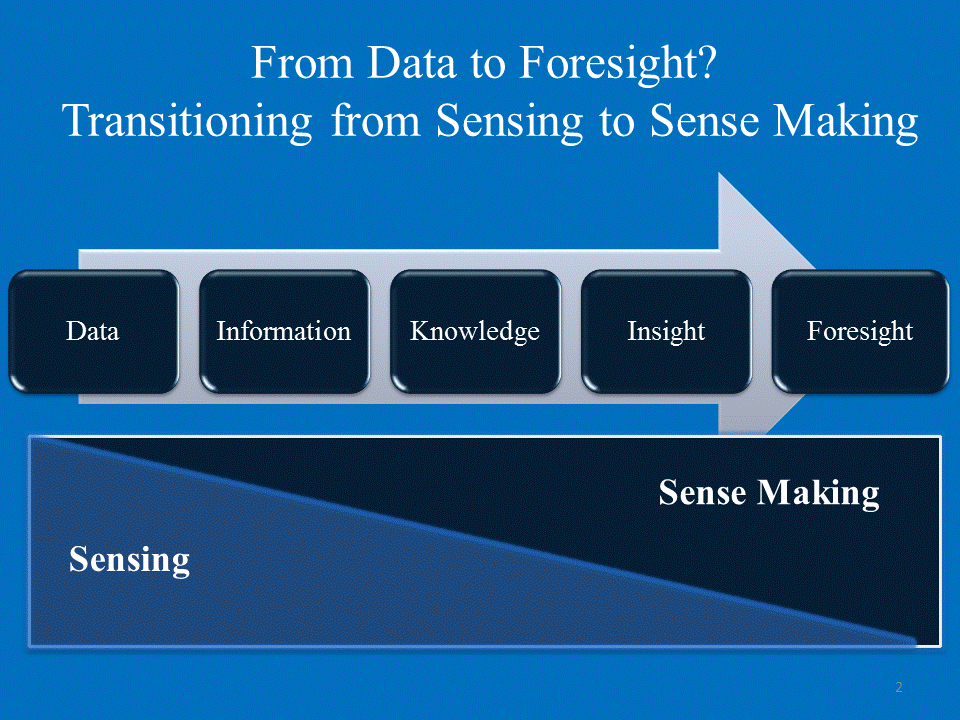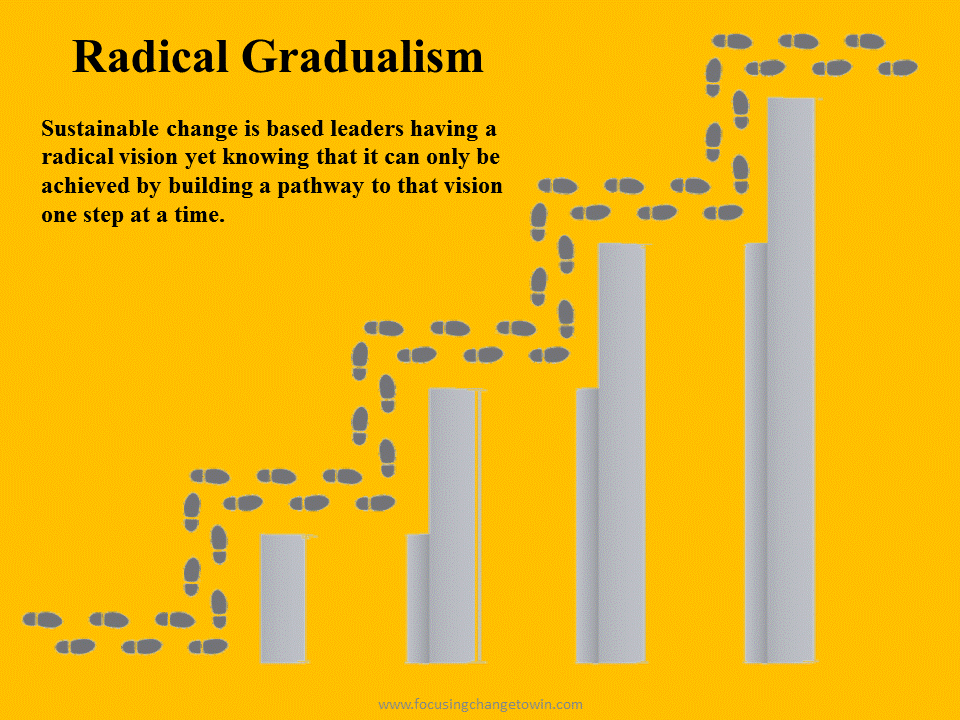What separates Thriving Organizations from those who just get by has been a fascination throughout my career. What follows distills a significant part that journey that led to conducting a global survey which lead to us writing “Focusing Change To Win” (2014). It’s main goal was to find out how much had changed in differentiating how Thriving organizations. The main conclusion that they still see competing and strategizing as being intimately linked. Strategic change and competition are seen as joint and inseparable processes. This means that they:

- Adapt competitively to external change by leaders having the capacity and capability to adjust to external change.
- Accept that strategic change is a continuous process on three dimensions – content, context and process.
- Understand strategic progress is neither linear nor sequential and so does not follow easily identifiable phases. The pattern really is continuous, iterative, uncertain and messy
- See competitiveness as not just against direct competitors but against the forces within their industry, country and globally.
- Identify and understand the competitive forces at play and how they change over time,
- Mobilize resources necessary for competitive responses in time and through time
1. Assessing Competitive Environments
Since 1980s research shows that thriving firms assess their external competitive world not just technically or by relying on a specialist function but by developing open learning systems. They work on ensuring that:
- Assessing competitive environments is not the preserve of one function or person.
- Creating strategies emerge from the ways a company acquires, interprets and processes competitive environmental information – at different levels.
Its characteristics are:
- Not a single act or done at one point
- Lacks innocence or isolation – people’s values shape the what and how of analysis
- Individual or collective beliefs of managers fundamentally affect environment assessments
- Identifying key competitive components and choice between alternatives are controversial
- Functions are more aware of their environments
- Links insights and ideas as to how to exploit emerging opportunities
1.1 Why is this so important?
A Deloitte’s survey showed no correlation between the performance of firms and whether they had a formal planning function (The Economist 1989). Subsequent studies up to 2013 showed no clear picture of the relationship between formal planning and firm performance. [2]
1.2 Sense-Making
Conversely the ability to absorb, process and act upon data from the environment, at all levels is a hallmark of success.
The problem of not only environmental “sensing”, but also “sense-making”. Sensing tends to be by individuals, often specialists, whereas sense making nearly always involves collective processing by asking questions like: What does this mean for the firm as a whole?
Management can then monitor the extent to which the firm is:
- Sensitive to environmental signals
- Collectively making sense of those signals
The sub-text to understanding the environment is the creation of the learning organization.
Successful sensing and sense making is based on four factors:
- Key people prepared to champion assessment techniques which increase openness
- Structure and culture encourages environment-facing of behavior and belief
- Environmental pressures are recognized
- Sense making is multi-functional which is core to operating the business
Even with these factors present there is no guarantee anything would change without a set of actions which stabilizes and impels the assessment capacity forward. There is a need for networks which link key stakeholders and interest groups.
Central to gaining competitive advantage is, “to discover how….creativity takes place”. It points to the capacity of the whole organization to learn from its environment. It means that sophisticated environmental sensing can be rendered virtually useless if collective learning is not an embedded process within the firm.
The value of such learning ensures the full implications of the firm’s view of its environment is captured, understood and retained at all levels. It can then inform:
- Actions over the long term
- How future shifts in the environment can be approached.
2 Leading Competitive Change
Of course ensuring that the environment is understood is important but the leadership challenges is ensuring that the organization learns and acts on such understandings.
There are over 200 leadership definitions covering many perspectives (Ross 1991). From this it is possible to separate out three models:
- Transactional – to exchange money, jobs and security for compliance
- Transformational – to encourage others to strive for higher goals
- Representational – to represent features of the change process/organization to others, often not their direct reports
Yet insufficient attention is given to how unpredictable change really is that makes the prospect of control illusive. Assertive action alone has limited value and may well be dangerous. Paradoxically, it is the accumulation of more modest preparatory actions that is all-important. This radical gradualism includes
- Assessing the political implications of a given strategy for instance, through problem-sensing and climate setting.
- Shaping the process in the longer term rather than through a single event.
The main weaknesses of earlier approaches were the search for universally applicable leader behaviours. Whereas effective change leadership requires actions appropriate to its context. In fact, there is evidence that solidifying apparently successful leadership behaviour into a single mould can become a competitive liability, e.g., Hill Samuel in 90’s and 1970s.[3]
Evidence continues to point to the need for variation in leadership ever since Manz et al 1989, and the need for “multiple influence procedures”.
“Leading change is not a one way relationship emanating solely form the leader. Leaders are themselves affected by the forces which seek they seek to manage”
Attempts in practice to achieve such a static, singular fit almost inevitably come undone as both leader and circumstances change.
One of the strongest features of Focusing Change To Win’s survey (2014)[2] which endorses Pettigrew and Whipp’s research is that leading change does not imply one leader. Great emphasis in those organizations studied and from survey contributors was placed on:
- Creating a broader notion of collective leadership at the highest level
- Inculcating over time a complimentary sense of leadership/responsibility at all levels
Both are vital for linking strategic and operational change.
2.1 Success Criteria
The critical tasks in leadership when managing change are more incremental often less spectacular than prevailing press images, i.e. Radical Gradualism. 
It involves linking actions of others at every level in the organization. Early and bold actions can be counter productive. More productive is creating a climate of change readiness while at the same time laying out new directions, but prior to precise actions being taken
The conditions needed are:
- Building a receptive climate, which involves justifying why the changes should take place
- Building the capability to mount the change
- Establishing a change agenda which sets direction, visions and values, which may take several attempts to get it right.[4]
Once in place then more direct mechanisms can be used which means that the skills of leading change therefore centers on coping with a series of dualities and dilemmas.
3 Linking Strategic & Operational Change
Confronting strategic change adequately is a live, difficult and complex process. A good analogy would be a fermentation process with all its connotations of volatility.
Too often change management is seduced into the fallacy linear sequence of goal setting and resource allocation brought on by the need to provide spurious certainty for senior executives.
The major problems of such an approach are that they:
- Underestimate the importance of the internal operation of the firm
- Ignore the critical dimension of process
Many approaches analyze snapshots where what’s really needed is to study motion pictures. So increasingly the uncertainty of our environment leads us to see strategic change involving streams of activity across time where managerial ability to cope with ambiguity is paramount. There is no easily isolated logic.
The linkage with operational change needs to be conscious and allowed to develop. It is the cumulative effect of separate acts of implementation that can immensely powerful. The position is:
- Translating strategic intent into operational form does not occur by single step or conversion, or a neat sequence of steps to a logical outcome; it may include clusters of iterative action in order to break through ignorance or resistance;
- Enduring aborted efforts or the build up of slow incremental phases of adjustment which then allow short bursts of concentrated action to take place.
- Separate attention is needed to open up the organization to the need for change and in due course to reach closure and reinforce the changes made
- Sustain pace and energy of the process – momentum cannot be taken for granted
- Attempting to carry out a given strategy invariably leads to its re-formulation.
- Iterative, cumulative and reformation-in-use translation processes (from strategy to operations) yields dividends in competitiveness
- Translating strategic intent into operational reality requires a compound set of techniques in order to make use of iterative. The challenges of analytical, educational and political problems in the translation process have to be met. Thus the new knowledge and insights into a given strategy that arise from its implementation have to be captured, retained and diffused within the organization.
4 Developing Competitive Human resources
In this context Human Resource Management (HRM) relates to the total set of knowledge, skills and attitudes that firms need to compete. It requires a longer term process that creates successive development spirals.
Specifically the role of HRM is to:
- Promote and develop the role of knowledge as a key competitive and differentiating weapon.
- Facilitate learning that generates, maintains and regenerates that knowledge
- Find ways of exposing knowledge contained in the procedural repertoires of the firm
- Ensure that the knowledge base of the firm matches changing competitive conditions
4.1 Collective learning can indeed be a vital “invisible” differentiable asset.
Learning is not just individuals acquiring new knowledge. Rather, it refers how people collectively change their knowledge, values and shared mental models of their company and its markets. Learning therefore does not preclude training, it simply goes further. The fallibility of conventional training regimes shows that only between 25%-40% of the intended knowledge is ever conveyed. The need is for a much broader approach which embraces
- Structural adjustment
- Experimentation
- Development of appropriate language
- Reshaping attitudes and values.
The second major requirement concerns the assumptions behind the learning. It involves spirals or cycles of observation, reflection, hypothesizing, experimentation, action and “hands-on” experience. Knowledge in the mind of the experimenters then has to be codified and diffused within the organization through behaviour and support.
4.2 “Unlearning”
Often overlooked is the necessity for breaking down entrenched knowledge and beliefs – “unlearning”.
The ability to shed outmoded knowledge, techniques and beliefs as well as learn and deploy new ones to carry out strategies is crucial. Crucial to have the ability to do so faster and more effectively than your competitors becomes almost priceless competitive advantage.
5 Change Management Coherence
This the ability to hold a firm’s strategic thinking together, while at the same time carrying out the reshaping and adjustment which new or emergent strategies demand.
It relies on managing the tensions between the organization’s new strategic position and both the internal and external relationships of the firm, while integrating these two over time
The problem of developing consistency in managing strategic change and competitiveness is that it relies on people embracing both thought and action, intra- and inter-firm relations. Attaining coherence relies on solving analytical, educational and political problems while managing strategic change and competitiveness.
The problem of attaining coherence lies in how often official goals and internal dynamics diverge. In other words, contradiction within corporations prevents change – the formidable obstacles to which many give little attention. As Kanter (1983, 2013) shows there are many “rules for stifling innovation”. These include
- Multiple layers of approval for new projects;
- Intensive control and counting;
- Secretive decision making;
- Suspicion of new ideas.
This is the most complex of the five factors. In many ways the requirements for coherence arise from the demands of the other four. Its subsidiary features are:
5.1 Building Networks
One of Coherence’s core capabilities is developing primary and secondary networks in order to build up, for example, the vital set of complimentary assets which it needs to exploit its knowledge base.
- Primary networks – relationships between a firm and others which are directly concerned with generating new knowledge bases.
- Secondary networks – wider relationships which affect the firm’s process of generating and altering its knowledge indirectly
These networks provide:
- Competitive advantage through co-ordination.
- Stronger value chains, they can also contribute to changing competitive position of firms and industries.
- Co-operation which can be learnt including; local cultural and market conditions, techniques of partner relations development, negotiation skills related to joint ventures and structural arrangements specific to collaboration.
- Collaboration competencies which are often truly invisible assets which cannot be readily purchased and controlled.
5.2 Strategic Positioning
This can be generated by attending to four elements in strategic thinking:
- Consistency – not present inconsistent goals
- Agility – by adaptive responses to changes in its environment
- Advantage – continually working to maintain competitive advantage
- Feasibility – avoid creating unsolvable problems and overwhelm its resources
In other words, the strategic position is directed towards creating identifiable competitive bases
that does not impair its whole implementation
5.3 Secondary management action
The range of secondary and complimentary management action is crucial;
- Coherence of purpose among senior management, even though individuals may differ
- HRM must produce a knowledge base complimentary to other strategic conditioning features
- Coherence in the treatment of customers, suppliers, distributors and collaborators
- Manage a series of interrelated and emergent changes
Summary
Today’s disruptive technologies are accelerants that speed change, already fueled by customer and competitor access to competitive information. The key to thriving in such a climate is creating agile structures, processes and developing people that are change expectant. This can be achieved if leaders see their role as enablers rather than controllers and can distribute both responsibility and authority to the lowest levels in their organizations. For this to happen it means that everyone needs to be aligned and committed to the organization’s “Mission Intent” where leaders are translators and alignment specialists so that every change is not treated with casual assumption and arrogance that “everyone will get it!”
[1] This is based on Pettigrew & Whipp (1991), Nick Anderson (1996) Masters Dissertation
[2]Focusing Change To Win – Kelly Nwosu & Nick Anderson (2014)
[3] Some studies found positive relationships while some studies found negative relationships between strategic planning and performance (Fletcher et al., 2002; Glaister et al.,2008; Heriot et al., 2004; Hopkin and Hopkins, 1997; Kraus et al., 2006; O’Regan et al., 2008, Rudd et al., 2008; Shrader et al., 1984; Veskaisri et al., 2007).
Similarly several studies did not even find any relationship between strategic planning and performance at all for smaller enterprises (Fletcher et al., 2002; Kraus et al., 2006; Veskaisri et al., 2007). Sharader et al., (1984) found no systematic relationship between formal strategic planning and financial performance. Unni (1981), Robinson and Pearce, (1983), Sharader et al., (1989), Birley and Westhead (1990) and Covin (1991) found relationships that were small or insignificant (Fletcher et al., 2002
[3] Bass (2008) predicted the continued importance of both personal traits and situations to leadership. Bass argued that large, purely transactional organizations would give way to transformational ones as modern leaders become more innovative, responsive, flexible, and (Journal of Business Studies Quarterly 2014, Volume 5, Number 4, Jim Allen McCleskey)
[4] See Section 7, Focusing Change To Win – How Effectively Are You Communicating Change?
